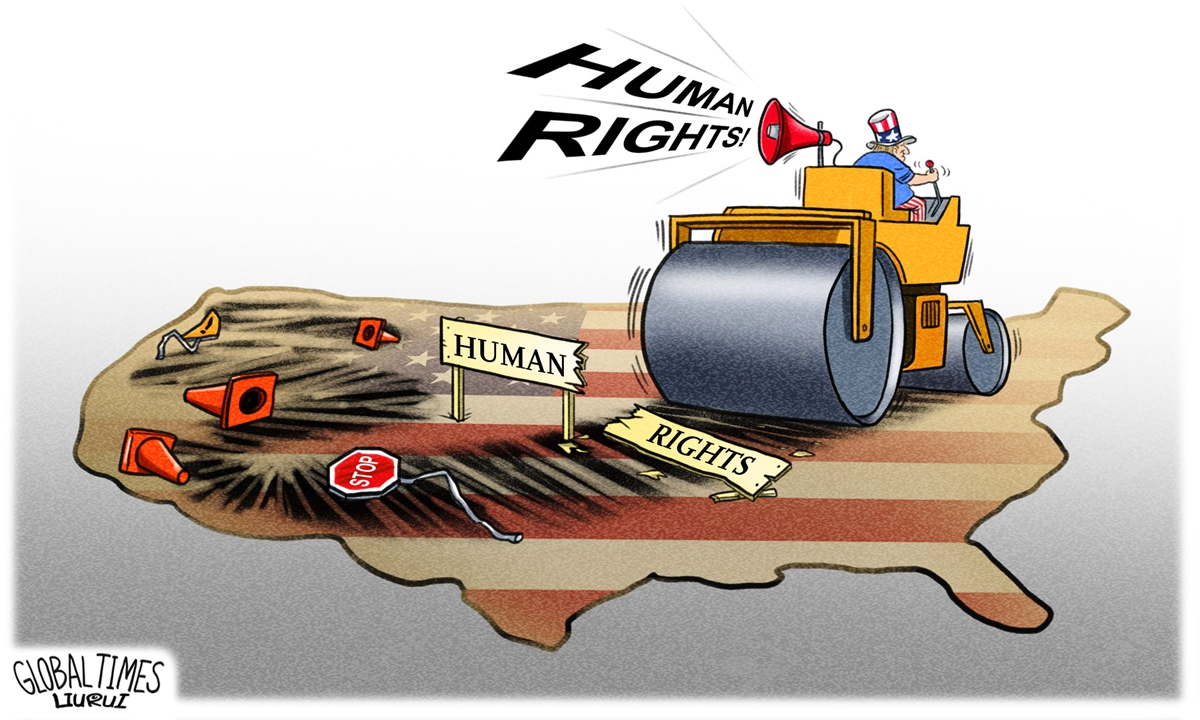
Illustration: Liu Rui/GT
"As a Shoshone, we always had horses. My grandfather always told me, 'stop kicking up dust.' Now I understand that it was because of the radioactive fallout."
The Shoshone native American tribe has long been considered "the most bombed nation on earth" as their sacred land was turned into a US nuclear weapons testing site. Today, the devastating effects of US ambition in the nuclear arms race with the Soviet Union during the Cold War continue to victimize generations of native American tribes.
In a recent interview with Russia Today, Ian Zabarte, head of the Western Shoshone native American tribe revealed that there were 928 tests conducted on the land of the Shoshone tribe from 1951 to 1992, producing nuclear fallout of around 620 kilotons, approximately 48 times the amount of the Hiroshima bombing in 1945. According to the tribe's record, the testing program killed thousands of local residents and left many with nuclear-related cancers and other illnesses. The only official document reporting the health and safety information regarding the nuclear testing comes from the US Department of Energy (DOE), which still remains classified.
The tragic destiny started with the Treaty of Ruby Valley in 1863, when the Western Shoshone agreed to hand certain rights to the US government as a gesture to maintain peace and friendship. According to the treaty, the Shoshone, who had been living on the land for at least 10,000 years, would continue to own it but allow the US government to establish military posts and mineral mines there in exchange for economic gains.
However, for the US government, the land was regarded as a prime site for nuclear tests, which also perfectly served its purpose of "racial cleansing." In 1951, in violation of the treaty, the US government established the Nevada Test Site on Shoshone territory. Since then, the once peaceful land has been plagued by nuclear bombing tests for decades. The US government intended to "commit genocide because these things were developed without our consent," and "there are test series with specific goals to expose humans to radiation," said Ian Zabarte. To date, the US government still turns a blind eye to the adverse health consequences of the testing program with the affected tribal residents receiving no official compensation.
Besides Shoshone, the Navajo Nation also falls victim to the toxic repercussions of US nuclear aspiration. Starting from the 1950s, thousands of Navajo people worked in local uranium mines, but were poorly paid, uninformed about and unprotected from the dangers of uranium dust inhalation and chronic radiation exposure. According to Vox News' investigation, though lacking in comprehensive analysis of adverse health effects, various studies have linked mining areas in Navajo Nation to higher rates of cancer, kidney and cardiovascular diseases and birth defects.
In 1979, a tailings disposal pond breached its dam, pouring almost 100 million gallons of nuclear waste into the Puerco River and onto the Navajo Nation. A National Public Radio report shows that the Navajo community is still reeling from the largest release of radioactive material in US history. The incident resulted in the contamination of the whole river as well as the groundwater. The US Environmental Protection Agency (EPA) eventually declared the area a Superfund site, a polluted location requiring a long-term response to clean up hazardous material contamination. Unfortunately, the only remedy from the EPA so far is to move the local Navajo residents from the pond to a nearby city. "Indigenous people are being used, removed and uprooted at the US government's will," implored a local resident, "to me that's no difference to a genocide."
The nuclear holocaust of the Shoshone and Navajo tribes has become an undeniable reality of the US government's systemic human rights abuses against native Americans. According to Dunbar Ortiz, an American historian and advocate for American indigenous group's rights and justice, the Convention on the Prevention and Punishment of the Crime of Genocide is applicable to US-Indigenous relations since 1988 when the US Senate ratified it and any of the five acts (which could be defined as "genocide") listed in the Convention can be applied to US crimes against native Americans.
It is time for the US to redress its past wrongs against the native Americans so that the dead can rest in peace and the survivors can enjoy basic human rights.
The author is a commentator on international affairs, writing regularly for Global Times, China Daily, etc. He can be reached at xinping604@gmail.com




